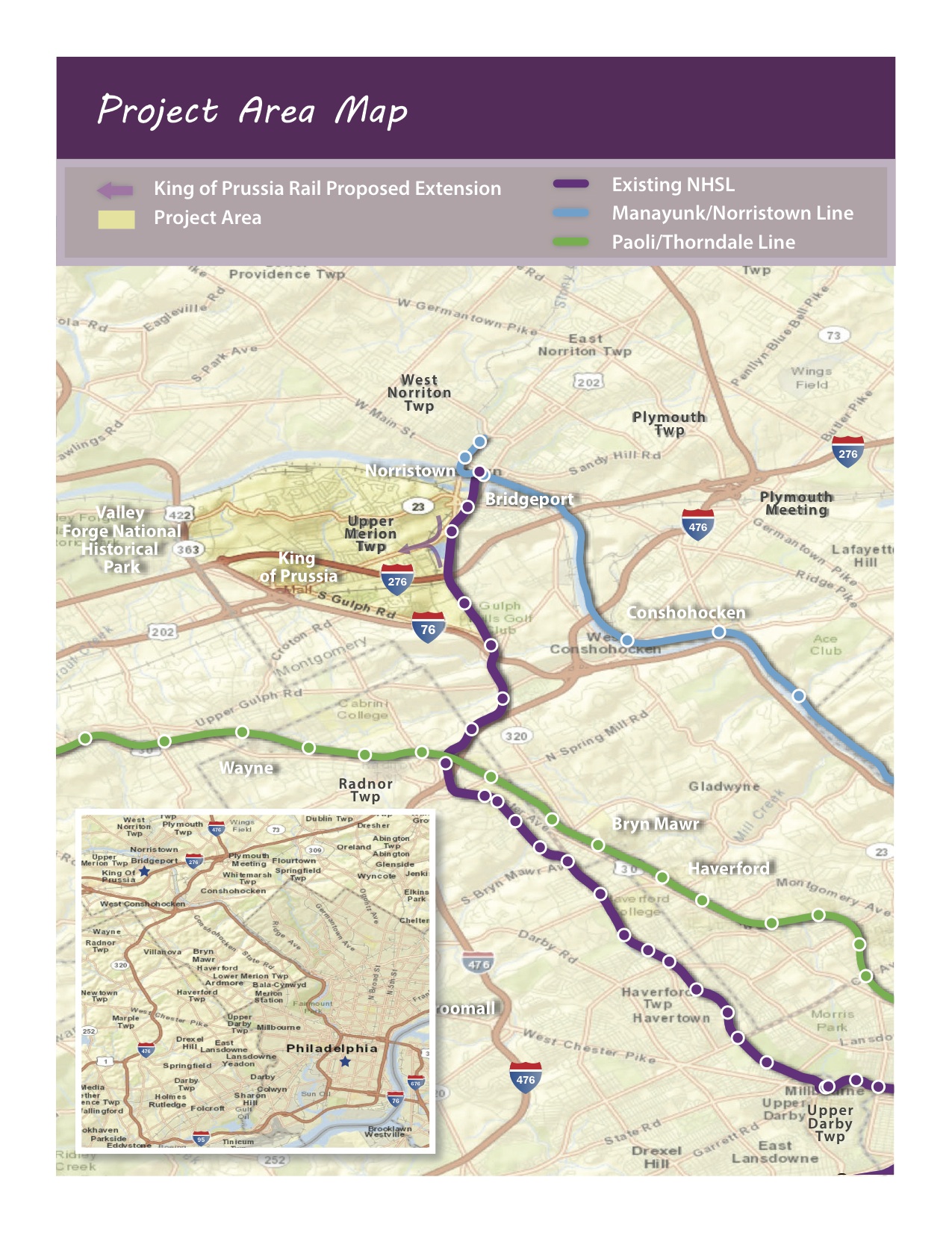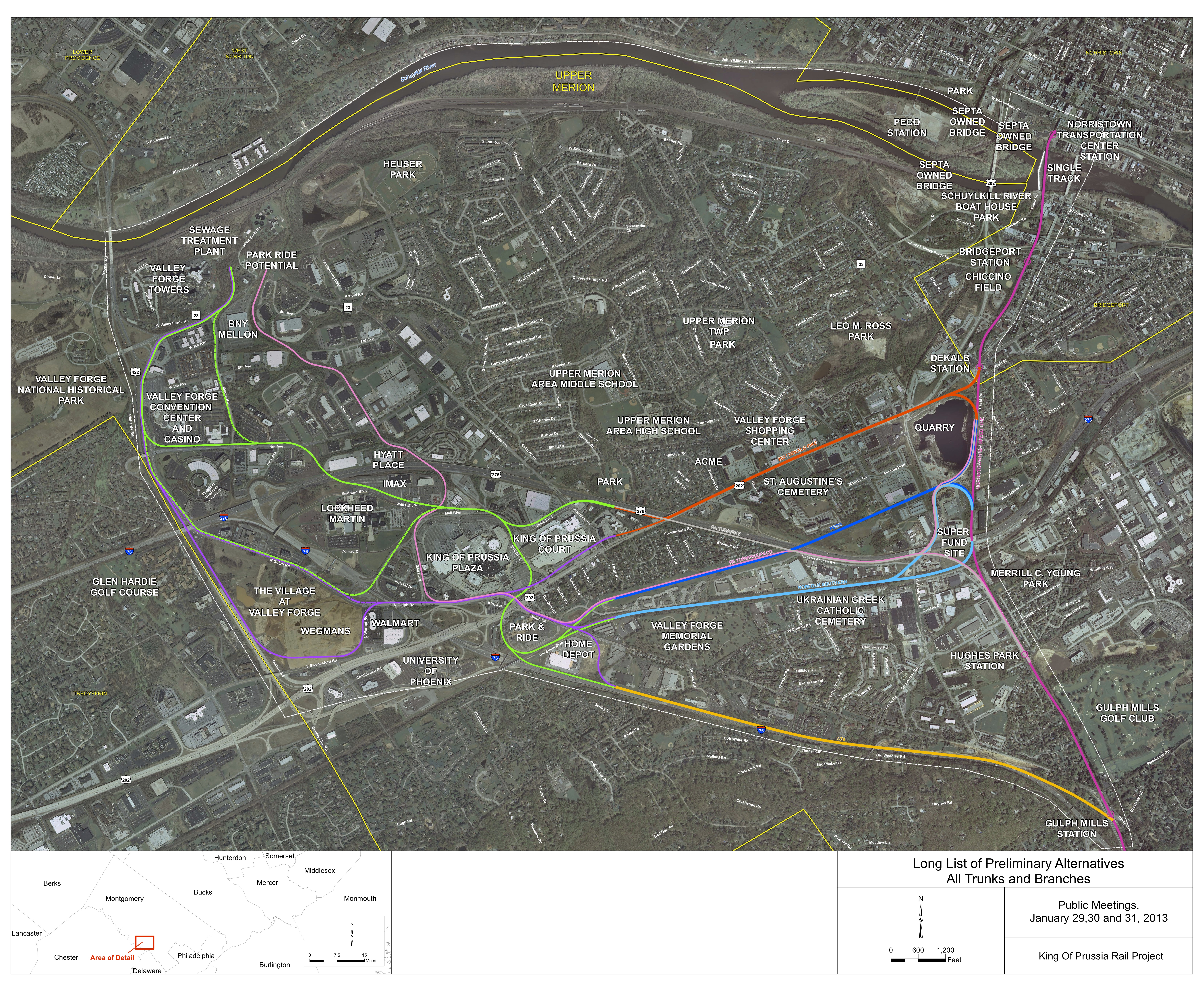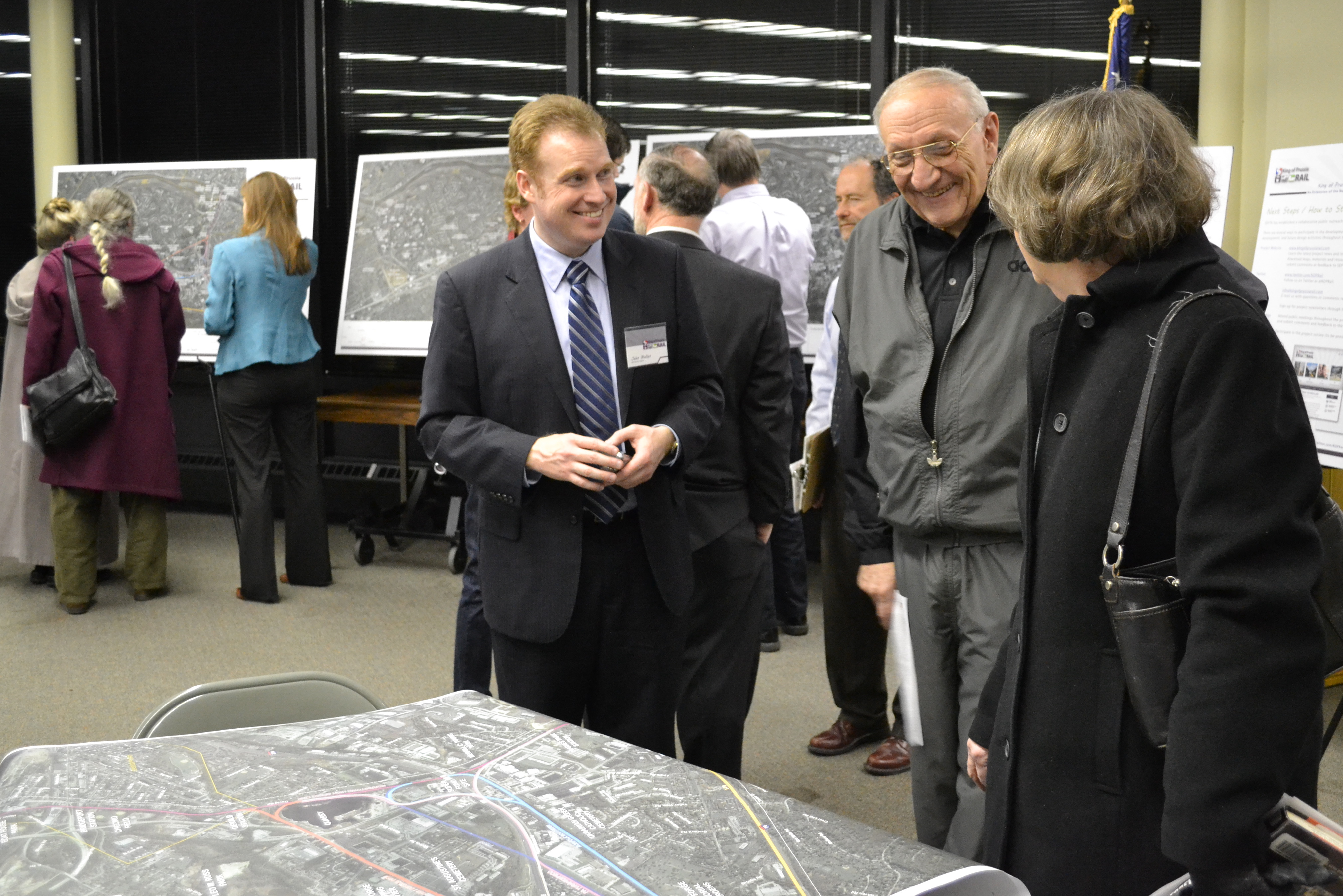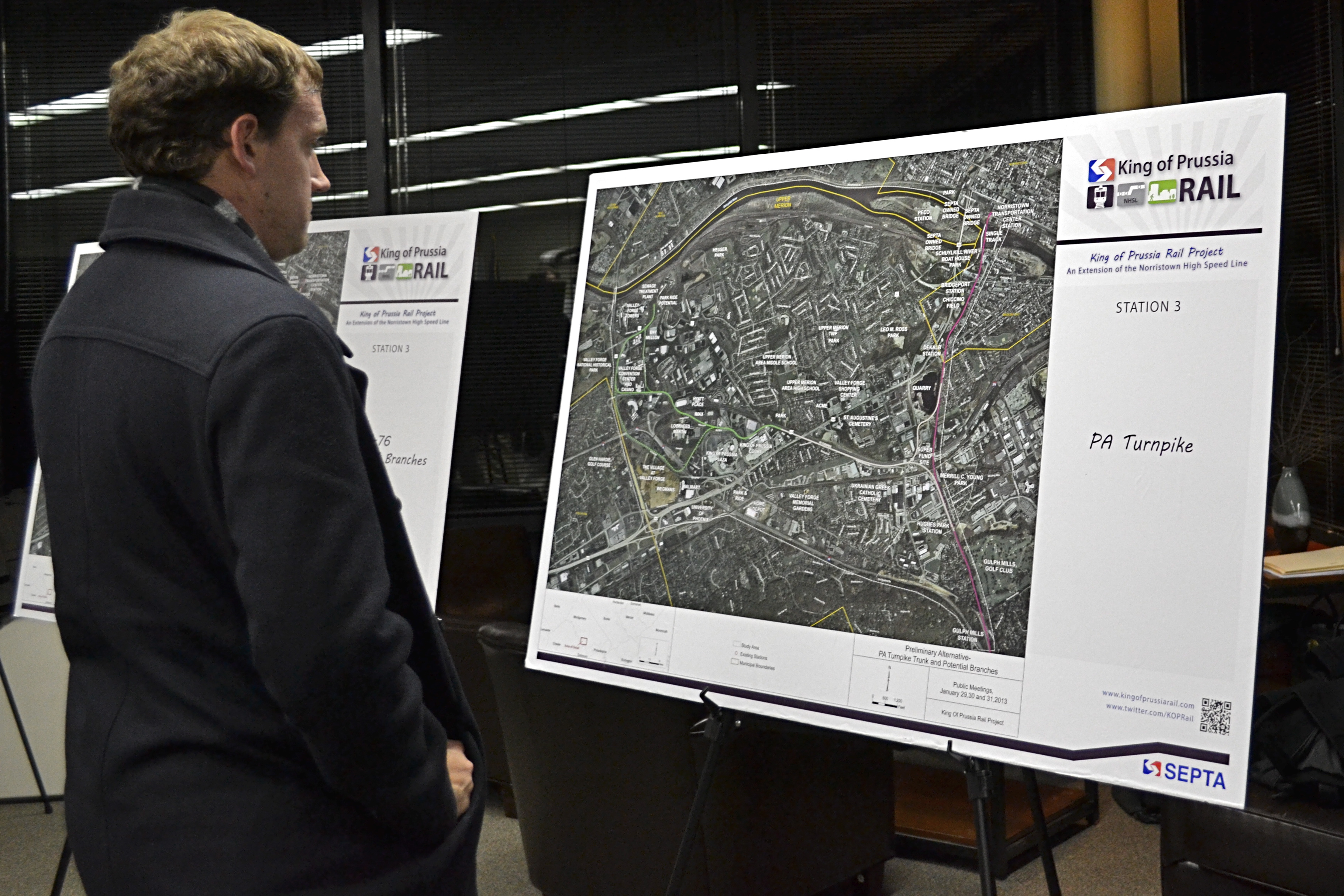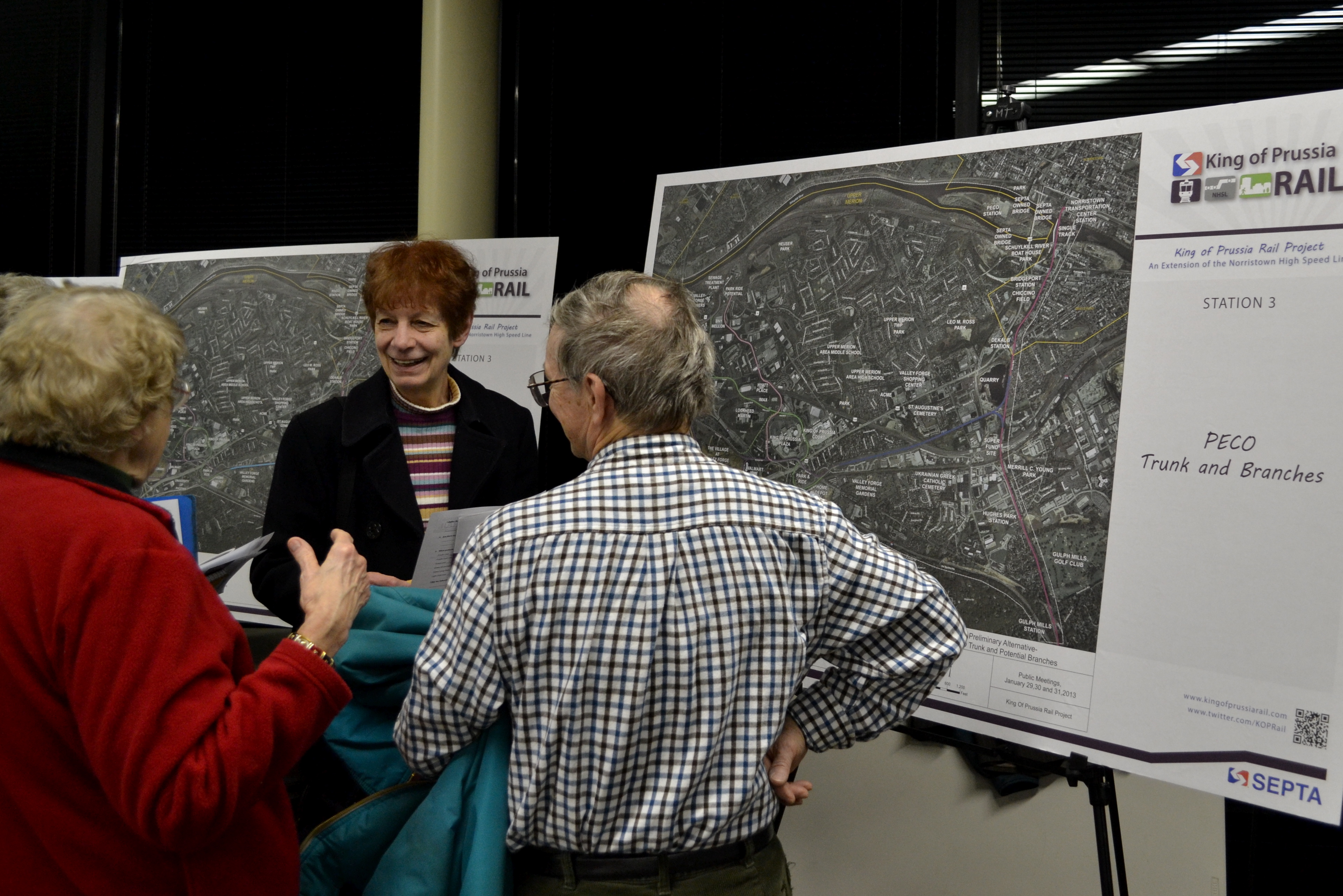SEPTA hosts public meetings on King of Prussia Rail Project
Traffic on the way to Tuesday night’s King of Prussia Rail Project public information session should have been a reminder why an alternative form of transportation could benefit the area. Rush hour congestion filled the Schuylkill Expressway from Philadelphia to the meeting at the Valley Forge National Historic Park – a trip that SEPTA hopes could soon be possible by rail.
In the fall of 2012, SEPTA began the process of looking at a new rail project, a type of spur extension that would branch off from the Norristown High Speed Line (NHSL) and bring riders to the King of Prussia Mall, the local business district and area attractions.
A captive market
Already, 68,000 people travel to the King of Prussia Mall each day for a total of 25 million annual visits. Another 1.5 million people visit Valley Forge National Historic Park each year.
There are more than 57,000 jobs in Upper Merion, 12,500 jobs at the King of Prussia Mall and 19,000 jobs in the nearby office parks.
“You could almost make the argument you’ve got a captive market place,” said Byron Comati, SEPTA’s director of strategic planning and analysis. “You already do for transportation.”
Four thousand people ride the five bus routes to and from the King of Prussia Mall each weekday, but those are some of SEPTA’s least efficient routes because the five highways that converge in the area are some of the region’s most congested.
That’s precisely why SEPTA is leading the charge for this project. The goals, Comati said, are to decrease the region’s traffic congestion and provide a faster, more-efficient one-seat ride to and from the King of Prussia area.
“It’s one-seat in the sense you would be able to get to this King of Prussia area in one ride depending on where you start your journey,” Comati said.
Rides to and from 69th Street Transportation Center, the Norristown Transportation Center or stops along the current NHSL would qualify as one-seat rides, that is, rides that don’t require any transfers.
Preparing for growth
A major driving factor for this King of Prussia Rail Project is a need to prepare for future job growth and, at the same time, move away from the area’s auto-centric history.
Upper Merion and the King of Prussia Business Improvement District (KOPBID) are in the process of rezoning to allow more density and height, thus more space for growth, in the business park. By 2040, the township expects it will have an additional 5,000 jobs, a total of 62,100.
“This isn’t just a transportation decision,” said Tony DeSantis, treasurer of the Delaware Valley Association of Rail Passengers (DVARP). “It’s a land-use decision.”
DeSantis said DVARP has always supported this project.
“If you think about the next generation and the next generation you’ve got to build something like this,” he said.
Timeline
Comati admitted Tuesday that it is daunting to look at the project timeline for the first time. Because SEPTA would seek federal funding, the project becomes a federal process with several steps and stages.
“The federal process is very rigorous,” Comati said. “They kick the tires several times. They kick the undercarriage, and they kick all the other body parts, it seems to me.”
In total, the project could take nine to 10 years.
SEPTA began the first phase – developing the alternative analysis – in the fall of 2012. In total, that phase is projected to take two years. Then there would be a one-year final environmental impact statement phase, a three-year engineering, design and program management phase and a three to four-year construction phase.
At Tuesday’s meeting, SEPTA was able to share nine alternative analysis design options with members of the public. Before SEPTA can apply for any federal funding, Comati said, a consensus has to be reached as to which of the design options is best.
“We’re blessed with many options,” Comati said.
Funding
SEPTA plans to apply for federal funding, which if approved would provide 50 percent of the construction costs. There would be a local match component but it is unclear where that funding would come from. Comati said the state, Montgomery County or a self-imposed local tax system might be contenders for the local match.
“There’s a burden of cost that has to be spread,” he said and explained that none of the local municipalities would be asked for money.
A Montgomery County representative at the meeting said the county, like all of the other players, will wait to see if this project is a viable option and what the necessary investment might be before it signs on.
There is also a chance of public-private funding as many private businesses have a vested interest in such a rail connection.
In the early 2000s SEPTA had plans to pursue a King of Prussia rail like this. At that time however, other projects forced this to the back burner. Comati said around 2002 or 2003, the estimated project cost was between $360 million and $380 million. He said now the cost is more than $400 million. How much more is still unknown.
Community concerns
SEPTA has already met with state, county and local governments, with business owners and other stakeholders and with technical advisors. So far the groups have been supportive, Comati said.
“It’s very refreshing to see everybody is looking at this with a positive attitude,” he said.
At Tuesday’s meeting, though, some area residents had mixed feelings.
Residents questioned storm water run off and aesthetic concerns, which Comati said SEPTA will take into account during the alternative analysis and design processes.
One resident asked if parking would be provided at any of the King of Prussia Rail Project’s proposed stops.
Comati said it is too early to tell for sure. There might be a park and ride built at the end of the line, but at this point, because of land constraints, it would be difficult to include additional parking amenities.
It’s a balancing act he said. How many people do we want to bring into this area that are bringing cars as well?
Others meeting attendees said they are afraid SEPTA and those leading the project won’t really listen to the community’s concerns.
Local resident Jackie Powers stood and spoke to suggest otherwise.
Powers said when SEPTA first brainstormed about this project around 1999 or 2000, there was a threat that the proposed rail would cut through her community and require multiple homes be torn down.
SEPTA listened to the concerned residents then, she said, and the alternative route they suggested was included in the nine potential models SEPTA had on display Tuesday.
“I have to say they listened to us in prior years, so I have faith,” she said.
Two additional public information sessions remain this week.
Wednesday, January 30:
Villanova University
Garey Hall- Ground Floor, Room 10A
Spring Mill & East County Line Road (SE Corner), Villanova, PA 19085
Thursday, January 31:
Montgomery County Planning Commission
Conference Room – 2nd Floor
One Montgomery Plaza | 425 Swede Street, Norristown, PA 19401
At some point after these meetings, SEPTA will launch a public opinion survey. In the meantime, more information can be found online http://www.kingofprussiarail.com or www.twitter.com/KOPRail.
WHYY is your source for fact-based, in-depth journalism and information. As a nonprofit organization, we rely on financial support from readers like you. Please give today.



